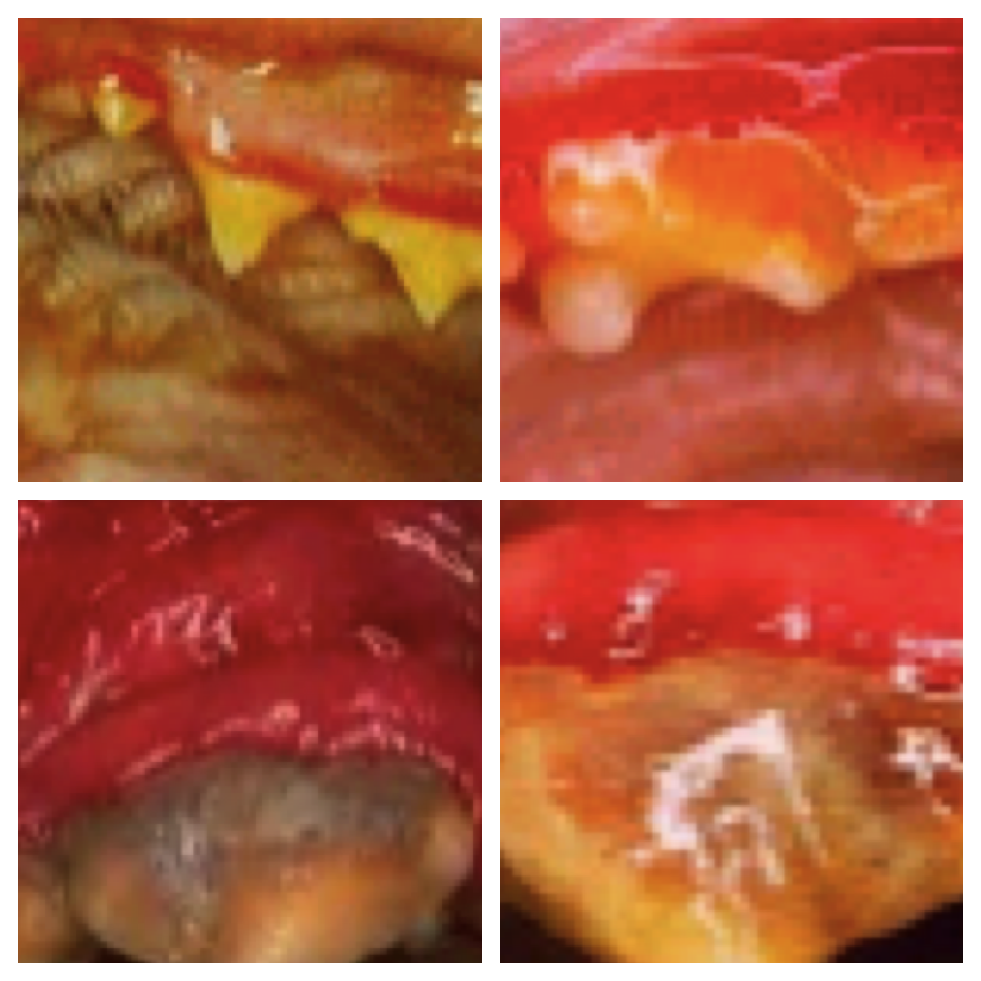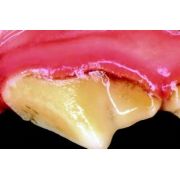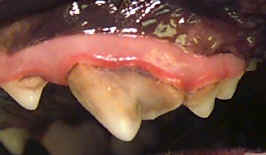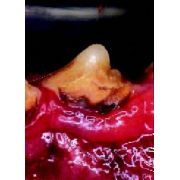Table of Contents
Overview | Treatment | Home Treatment & Supplements | Periodontal Disease | Halitosis
Summary:
"Canine gingivitis remedies are needed when there are signs of gum inflammation. The condition is reversible if treated and then followed by daily use of a toothbrush. If gingivitis in dogs is not treated, it can appear in several weeks and then result in periodontitis, a condition where there is bone loss and problems with the ligament tissues that support dog teeth. While gingivitis can be reversed, when it advances to periodontitis, it cannot. Periodontal disease is the most common ailment seen in Veterinarian's offices.
Treatment involves a dental cleaning and tooth extraction if needed. Remedies include chlorhexidine, chews, rinses and gels. After treatment, chews and diet along with daily tooth brushing could help maintain dental health. For daily maintenance we suggest selecting diets, treats and chews,from this list endorsed by the Veterinary Oral Health Council.
See a veterinarian if your dog has red gums, or has bumps or lumps on the gums. Other indicators that require a trip to the veterinarian include bleeding gums, signs of tartar stains, tooth damage, pimples that surround the mouth, bad breath and drooling. Also if your dog favors one side of the mouth over the other.
Note that dental care at home is not a substitute for treating periodontal disease in a veterinarian's office. It should be used after a professional dog teeth cleaning."

Overview
Gingivitis is the first stage of periodontal disease. Canine gingivitis is reversible if treated before the disease advances too far. Brush the teeth well and it could be reversed. Most dogs who are over age 2 have some form of gum disease which usually occurs on the premolars and molars.
What Is Dog Gingivitis?
Canine gingivitis is a condition where food and bacteria are trapped below the gum line resulting in inflammation of the gingivae, the area referred to as the gums. The stuff that gets trapped is first called tarter, and then when it gets harder because no one removed it, it turns into plaque. Both plaque and tarter are forms of calculus.
Plaque tends to form on the tooth just below the gum line on the upper and back teeth first. Without cleaning, in as little as 36 hours, this plaque could harden and become tarter. Unfortunately tarter must be professionally removed since a brush is not effective. When gingivitis is treated it can be reversed and gum health restored. Once this happens, then daily brushing is needed to maintain oral health and to prevent periodontitis.
What Causes Gingivitis in Dogs?
If plaque or calculus is not removed, it changes the ph in your dog's mouth allowing bacteria to form around the gums. This bacterial plaque causes gingivitis, and if left untreated it eats away at the gums with the tooth eventually falling out.
Periodontal disease has been connected to kidney disease , liver, and myocardium (mid-section of the heart muscle).(1)
Your Veterinarian will rate the amount of disease affecting a tooth according to stages I through IV. Stages I and II can be resolved with cleaning and scaling the tooth. Stages III and IV usually involving removal of the diseased canine tooth and some gum surgery.
Poodles and smaller dogs tend to have bigger problems with plaque and tarter. Dogs that eat dry food and chew on bones tend to have less, and those that eat soft foods tend to have more.

Treating Canine Gingivitis
Like humans, a Veterinarian can clean, polish and remove the tarter and plaque. During this process your dog will probably be sedated or receive an anesthetic. If the gum is badly diseased, the Veterinarian may remove part of the gum (called gingivectomy) and remove some teeth. Canine anesthesia is given to the dog either via intravenous (for procedures under 15 minutes) or through a tube that goes into the windpipe if longer than 15 minutes is needed.
See your Veterinarian if you see lumps, bumps, inflamed gums, bleeding gums, foreign bodies you can't remove, stains, damaged teeth, pimples around the mouth, drooling that just started out of nowhere or breath problems.
Your dog will be given antibiotics for 1 to 3 weeks after treatment.

Home Gingivitis and Plaque Control
Dog gingivitis home treatment starts with the use of products such as rinses, gels and toothpastes. Most will reduce plaque accumulation but does not stop it. The first defense is the use of a toothpaste such as Virbac C.E.T. which has an antibacterial effect. CE.T. includes the enzyme Glucose oxidase which provides an antiseptic action.
Canine Gingivitis Remedies At Home
Dog Gingivitis Home Treatment: Option 1
A dog tooth decay home remedy and one of the canine gingivitis remedies that can be given at home include rinsing your dog's mouth with .2% chlorhexidine (Peridex or Nolvadent) 1x or 2x a day. Soak a cotton ball with this solution and gently rub the gums and teeth. Wash and massage the gums until healthy. Oral antiseptics such as Chlorhexidine is an antibacterial agent that has been shown to reduce gingivitis and plaque. The downside of this approach is that it can cause brown tooth staining and a reduction in taste sensation. It can be effective when used right after professional treatment during the time when the gums are healing.(2)
Veterinarians sell the dog gingivitis home treatment Stomadhex, which is a patch that is used for 10 days and that sticks to just inside the upper lip. The patch is time-released and contains chlorhexidine and nicotinamide (a vitamin). This approach helps to prevent plaque, tarter and controls bad breath.
Dog Gingivitis Home Treatment: Option 2
Another gum disease home remedy to treat gingivitis in dogs is to give your dog a pig or cow trachea, something you can buy in specialty stores. The cartilage and fibers will massage the gums and teeth while your dog chews. This will help clean plaque at the same time providing a natural dog gum disease home treatment.
Dog Gingivitis Home Treatment: Option 3
Another rinse and gel containing absorbic acid (vitamin C) and zinc that is available is called Maxi/Guard. It is an antibacterial helps with collagen production, which is the main protein in the gingiva. It reduced calculus accumulation, making it easier to control plaque. It does not reduce plaque directly.
Natural Support for Canine Gingivitis
There are several natural canine gingivitis remedies. They include:
Vitamin C and Vitamin E - Both are antioxidants that decreases swelling and pain associated with periodontal disease (vitamin C, 10/mg per pound, 2 to 3x per day; vitamin E 5-10 mg/pound of body weight, 1x per day, use mixed tocopherols when selecting a vitamin E product).
Bioflavanoids - Use Pycnogenol (.5-1 mg/pound) or grape seed extract. Another choice is an oil-based form of Coenzyme Q10 (1-3 mg/pound of body weight, 1x per day).
Folic Acid - Folic acid alone or as part of a B Complex supplement can help with canine gingivitis.
Myrrh - Soothes inflammation of the gums. Apply to your dog's gums with a Q-tip mixed with distilled water.
Echinacea - Used in periodontal treatment.
Arnica - Relieves symptoms associated with oral surgery.
Calendula Lotion - Promotes healing in the mouth and soothes ulcers.
Fragraria - May prevent tarter buildup.
Chamonilla - Decreases puppy teething discomfort.
Hypericum - Decreases oral pain.
You can also consider a herbal supplement made to help with gingivitis such as Pet Alive's Gums-n-Teeth to prevent pet gingivitis. This product contains:
- Organic Horsetail Herb (Equisetum arvense): supports body tissue with high silica content. Silica helps with strong teeth and bones.
- Conventional Spirulina Thallus (Arthrospira platenis): sea micro-organism that is an excellent source of chlorophyll. Makes Vitamin A available for use in the body which is essential for healthy teeth.
- Certified Organic Dandelion Leaf (Taraxacum officinale): has a beneficial effect on saliva production ((Kuusi T, Pyylaso H, and Autio K. "The bitterness properties of dandelion. II. Chemical investigations." Lebensm-Wiss Technol.1985; 18:347-349) and is a source of vitamin B, C,D, A manganese, zinc, magnesium, potassium, silicon, lecithin and iron.
Canine Periodontal Disease
Untreated canine gingivitis can result in canine periodontitis. If the gums are badly infected the infection will spread to the teeth roots, causing teeth to loosen or come out. Signs of periodontal disease include drooling and reluctance to eat. Review the canine gingivitis remedies on this page to prevent this from happening.

Canine Halitosis
Gingivitis may cause halitosis, or bad breath. If your dog's breath
smells bad, the gums are red or bleeding and there is the presence of pus at the gum line, your dog probably has gingivitis. To check your dog's
breath, pull back a lip and smell. Follow any of the recommended canine
gingivitis remedies for treatment.
Chew Toys, Aids and Dog Gum Disease Home Treatment
Chews toys can help clean dog teeth. However, products such as rawhide bones and nylon bones can cause a dental fracture. One rule of thumb is to use the "knee test." If you take the chew and hit yourself in the knee, and it can potentially hurt, do not give it to your dog. Tennis balls, while soft can also cause harm from abrasiveness and dirt stuck in the outer fuzz of the ball.
Pig Ears
One good dog home remedy for gingivitis prevention is the chew aid are pig ears (cartilage and pigskin). They are sold in pet stores as dried pig ears and are decay resistant by being smoked. The pig ears has an abrasive effect and have a low risk of causing a dental fracture. There is no research supporting or indicating that you should not use of pig ears. They are one of the safest chew aids available however in some dogs they may experience stomach upset. Only pay quality pig ears to avoid pathogens such as Salmonella.(2)
Rawhide Strips
Dog rawhide strips as a dog gingivitis home remedy is also recommended. The strips are sold under the brands Chew-eez and C.E.T. chews.
What are CET Chews?
CET chews contain glucose oxidase, which offers an antiseptic action that reduces bacteria. The abrasive nature of the chew reduces plaque and loosens tartar.
Chews As Dog Gingivitis Home Remedies
The chew DentaLife has been shown in studies to reduce stains, calculus, freshen breath (by reducing tartar buildup) and reduce plaque while improving gum health (reducing dog gingivitis). Studies show a 57% average reduction in tartar buildup. The product contains no artificial colors or flavors.
Dog Gingivitis Diet
No diet has been proven to prevent gum disease in dogs alone without also using daily brushing. In general dry kibble is better for keeping teeth healthy. The dry food has less residue in the mouth, reducing the amount of bacteria. The abrasive effect from kibble does not provide enough abrasion to keep the teeth clean.
There are several dog foods recognized by the Veterinary Oral Health Council as having a "significant effect on calculus and plaque." These include:
These diets work by providing the dog with over-sized kibble. The kibble is hard, but not brittle, has to be chewed in order to be swallowed. A dog's teeth has to penetrate the kibble, abrading the tooth surface and removing plaque. They need to be fed as the primary diet and not a treat.
Brochures
Sources
(1) Prevention and Treatment of Periodontal Disease. Dr. Cecilia Gorrel BSc, MA, Vet MB, DDS, MRCVS, HonFAVD, DEVDC, European and RCVS-recognized Specialist in Veterinary Dentistry, Veterinary Oral Health Consultancy
(2) Dental Home Care: What is Effective and Why; F.A. Hale, Hale Veterinary Clinic, Guelph, Ontario, Canada.
(3) "Pet Orthodontics"
Bellows, Dr. Jan, DVM
(Source for all Canine Dental pictures)
(4) "How to Brush Your Dogs Teeth"
Rosenblad, Dr. William
Petsplace.com
(5) Dog Owners Home Veterinary Handbook, 3rd Edition
Giffin, James M, MD, & Carlson, Liisa D., DVM
(6) The Doctors Book of Home Remedies for Dogs and Cats
Prevention Magazine
